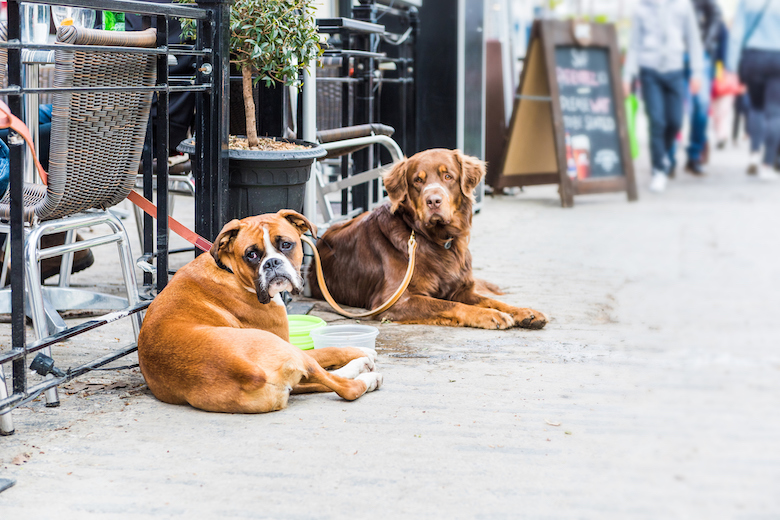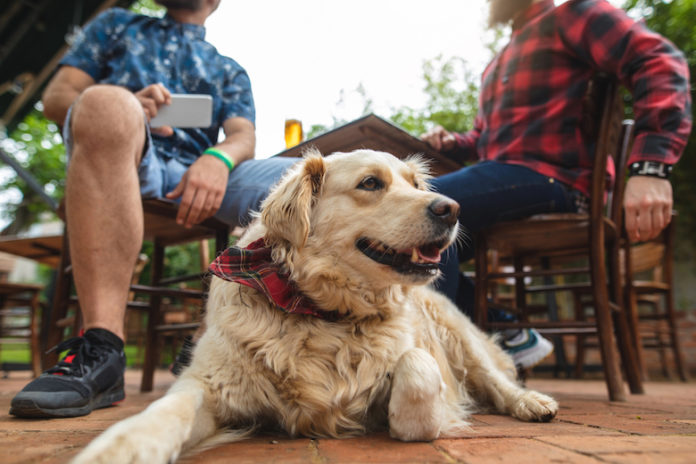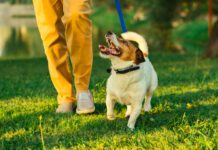These days, thanks to coronavirus, more and more restaurants are offering outdoor dining, and many are allowing dogs to accompany their humans, as some traditional outdoor restaurants have for years. You may have seen some very well-behaved dogs lying quietly at the feet of their humans as they dined outside Panera Bread and other eateries, and wondered “How do I get my dog to do that?” Here’s how.
Start teaching your dog to be a good dining companion at home
The first step is to get your canine pal to lie quietly at your feet while you eat in the comfort of your own home. Mat training is great for this. Start by reinforcing your dog for lying on a portable mat, rug or dog bed when you’re not eating.
Related: Mat Training Tips, December 2019.
When she is solid with this behavior, generalize it by moving the mat to your eating area. When she can do at least 10-15 minutes of duration on her mat while you sit nearby at the table reading a book or typing on your computer, add the eating part – short snacks at first, gradually increasing your food consumption to full meals. Ideally, your dog will just take a snooze while she waits. If not, it may help to give her a long-lasting chew of some type to keep her happy while you eat.
You do want to remember to occasionally reinforce your dog for staying on her mat, but you don’t want to feed her from your place at the table, as this may encourage begging or demand behaviors. Instead, have her stay on her mat while you get up, walk away from her, get a treat from a counter or shelf (or even from your pocket), and feed it to her as you approach from her non-table side. This way she won’t have expectations of getting treats from you while you are seated and eating.

How to dine al fresco with your dog
Now it’s time to take the show on the road. For purposes of this article, we are assuming that your dog is already comfortable and reasonably well-behaved in public. If not, you’ll need to back up and start there. You do not want to try to eat at a restaurant with an ill-behaved dog! (Please note: It is never a good idea to take dogs who are reactive or have aggressive behaviors to public eating places.)
Start by making several trips to the outdoor restaurant(s) of your choice, and do some good manners training practice outside the eating area. Take your dog’s mat along, and practice her mat behavior there as well.
When she can do well with “Mat” outside the eating zone, you’re ready for the real thing. Visit your restaurant of choice, enter with your dog and her mat (and a long-lasting chew, if needed). Select an out-of-the-way table so you’re not smack in the middle of the traffic pattern, invite your dog to lie down on her mat, and take your seat.
It should go without saying that you never let your dog approach, bother or otherwise interfere with the dining experience of other customers. If they ask if they can pet your dog, that’s up to you. If your dog might not handle it well, or you don’t want to disrupt her mat tranquility, just say sorry, but no.
Be ready to leave at any time if your dog tells you she can’t handle it. (Let your waitress know in advance that this might happen and you’re not running out on the bill, you’ll be right back to pay. Then stash your dog in the car –running, with the air conditioning on, while you dash back to pay.)
Dine alone at first, so you aren’t distracted by companions and can give your full attention to your dog and her training program. Start again with light snacks so you can keep your eating time short, and as she demonstrates to you over several visits that she’s ready for more, work your way up to a full-course meal with your friends.
Happy doggie dining!
Top photograph: FluxFactory/Getty Images
Read Next: How to Train Your Dog to Calmly Walk on Leash






Why would anyone think this is enjoyable for a dog? Just sitting, tethered, on a hard concrete slab, while the owner eats and jabbers with friends, for who knows how long. Instead of viewing dogs as sources of amusement to be at our beck and call when it’s convenient for us, how about more consideration of quality of life for the dog?